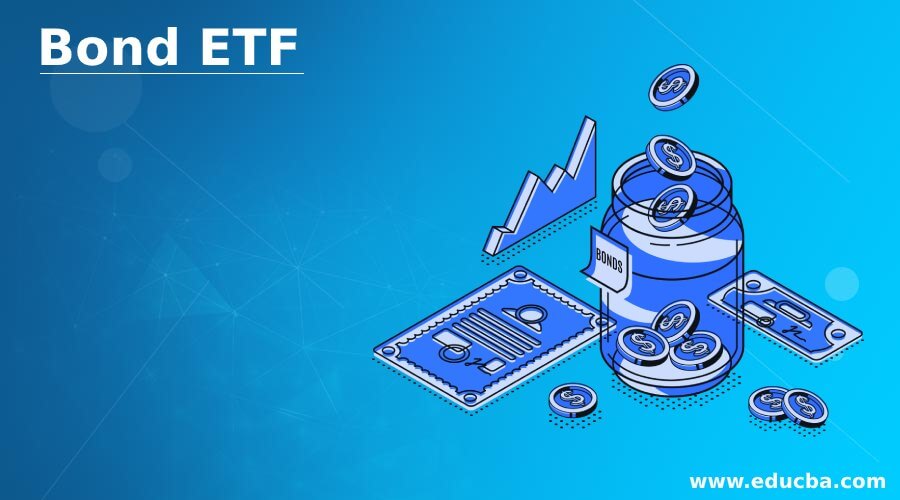Updated July 17, 2023
Definition of Bond ETF
Bond ETF is an exchange-traded fund investment option that invests clients’ money into fixed-interest securities. They mainly invest in corporate bonds and treasuries.
These are low-risk investments and provide regular coupon payments every month. It helps the individual investor get exposure to bond benchmark indices, which they would not have been able to do otherwise.
Explanation
Bond ETFs are bought and sold on major exchanges, allowing the investor to find attractive prices for their securities, unlike traditional bonds bought and sold by the broker. It helps investors to gain exposure to the bond market with the added benefit of transparency of stock trading. It also suggests that bond ETF is more liquid than traditional or mutual funds. Investors can buy or sell bond ETFs anytime if the bond market is not performing well.
The return of bond ETFs is paid monthly dividends, and any capital gains are produced annually. On the taxation aspect, it is subject to income and capital gain tax, but capital gain tax does not form a large part of the return, unlike share trading. Bond ETFs do not create a significant amount of the bond market, so if they do not perform very well, they will not necessarily impact the entire bond market.
How Does it Work?
The below points can help us understand how does bond ETFs work?
- Bond ETF, like traditional bonds, provides a regular coupon payment. But unlike conventional bond that pays the interest on a half-yearly basis, bond ETF pays it every month, and the value of the coupon also varies from month to month. This is because bond ETF invests in different assets with different maturity dates so some bonds will be dues for monthly coupon payments.
- The bond ETF manager cost-effectively keeps track of bond indices; the task is a little complicated as most of the bonds are not liquid and thus do not have a secondary market where they can be traded. Also, the asset in the bond ETFs keeps changing and maturing. Instead, bond ETFs are bought and sold when they are expired.
- Most liquid bonds are selected for index representation purposes, which helps the bond ETF architect get around the liquidity problem.
- Lastly, as mentioned earlier, it is subject to income and capital gain tax.
Example of Bond ETF
Some of the examples of bond ETFs are as follows:
- Government Bond ETF: These are issued by the government; some of the examples are:
- Mortgage back securities ETF: It is backed by real estate mortgage loans and helps banks offer mortgage loans.
- Us treasury ETF: They are issued by the US government and carry minimum risk and low return.
- Treasury-inflated protected securities: In these bond ETFs, the principle value increases or decreases in line with the consumer price index or inflation.
- Corporate bond ETF: These bonds ETFs are issued by corporate or private organizations. Examples are as below:
- Investment Grade ETF: In this category, bond ETFs are issued according to different ratings; for example, bond ETFs with AAA or BBB ratings are considered high credit rating bond ETFs; thus, they carry a minimum risk of default and low return as well.
- Junk Bond ETF: These bond ETFs are issued by a company with a lower credit risk rating. They generally offer a high rate of return, but the risk of default associating with these is also high.
Who Should Invest in Bond ETF?
The bond ETF is a low-risk associated investment option. Therefore the investors who do not have a very high-risk appetite and are looking for security on the return perspective should invest in the bond ETF.
Also, since it provides a liquidity option, i.e., investors can buy and sell them when distressed, investors looking forward to the short-term investment or saving option should invest in bond ETFs.
Advantages
Some of the advantages are mentioned below:
- It helps investors diversify their portfolios by investing in various fixed-interest assets with different maturity periods, like long-term, mid-, and short-term.
- It majorly invests in fixed interest assets,s thus providing its investors a low-risk investing avenue.
- Unlike traditional bonds, bond ETF is liquid and allows its investors to reach the bond market as they are traded on stock exchanges.
- IT can cater to the exact risk-return of the client in terms of fixed asset securities. This happens because bond ETFscomes in a different form, sot an investor can select bonds they want to include in their portfolio.
- Bond ETFs are traded on stock exchanges; thus, they provide the investor the price transparency.
Disadvantages
Some of the disadvantages are mentioned below:
- The investment manager fees associated with the bond ETFs are too high if compared to the low return; it erodes the central part of the return.
- IT majorly invests in fixed interest securities; therefore, they provide a low rate of return.
- Also, if the interest rate rises, the investor loses their chance to earn a better return on their initial investment.
Conclusion
It is an accessible option for investors, but investing in a traditional bond is difficult for an individual investor. Thu, bond ETFs have provided investors access to the bond market. It is a good investment option for regular monthly income and liquidity investors.
Recommended Articles
This is a guide to Bond ETF. Here we also discuss the definition and how bond ETF works, along with its advantages and disadvantages. You may also have a look at the following articles to learn more –



